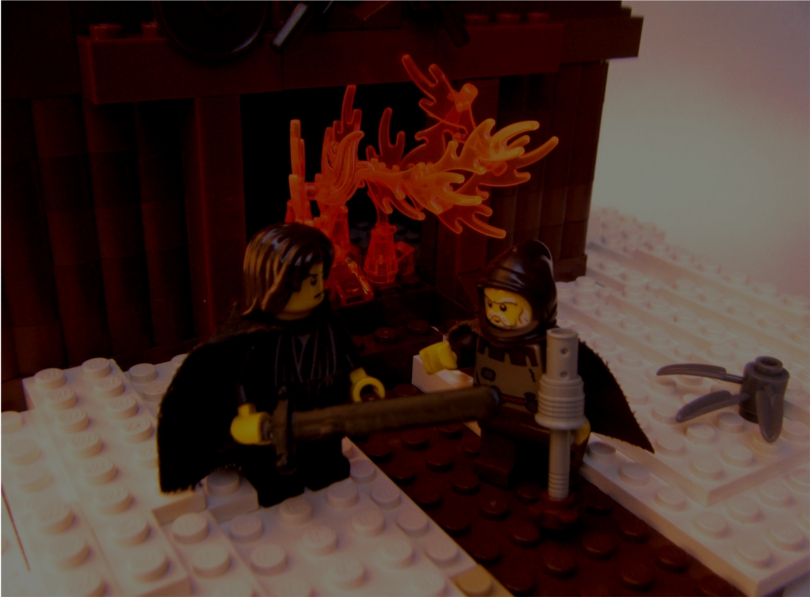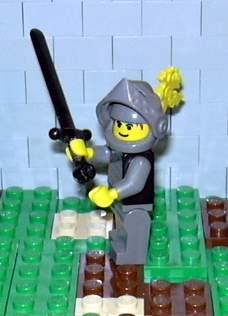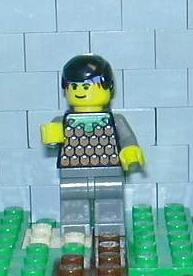The second tale in the collection also belongs to Part I of the book, tales of the First Age. Like "Of Tuor and his Coming to Gondolin," this second tale is found in The Silmarillion in a shorter form that puts it in the context of the larger tale of the High Elves and their fight against the Dark Lord; but unlike "Of Tuor," this tale is far more complete.
This tale is the "Narn i Chîn Húrin,"* the Tale of the Children of Húrin. In the Silmarillion this is the chapter called "Of Túrin Turambar," who is one of the titular children of Húrin and the main character of this tale.
Túrin is a Man, the first cousin of Tuor from the previous tale, about seven or eight years older than him, and he also loses his father, the great hero Húrin, in the battle when the Dark Lord Morgoth's armies destroy the great alliance of Elven kingdoms, crushing some of the Elven kingdoms in the process. After that, only three Elven kingdoms remain, all of which are hidden or guarded: Gondolin, which figures into Tuor's story; Nargothrond, and Doriath. Túrin's mother sends him to Doriath to be fostered, but she stays behind because she is pregnant and it's winter.
Fast-forward about twenty years and Túrin grows up and leaves Doriath on bad terms. He joins a band of outlaws and turns them into guerillas fighting Morgoth's orks and has some success before he is betrayed and captured. His best friend rescues him by night, but Túrin kills him thinking he's an ork. Another freed prisoner leads him to the secret Elven kingdom of Nargothrond.
Once again, Túrin becomes a leader and the Elves of Nargothrond begin to wage open war on the forces of Morgoth. This attracts the Dark Lord's attention and he sends a massive army led by the dragon Glaurung to destroy the city, which happens--largely thanks to Túrin's pride. The dragon lets Túrin go, to mess with him further (I should have mentioned that Morgoth put a curse on Húrin's family) and reminds him of his mother and sister suffering in his homeland. Túrin then abandons any thought of freeing the captives taken at Nargothrond, which included his One True Love/Elven Princess to go and rescue his family.
That's where this picture comes in...

Túrin arrives back home only to discover that his mother and sister are long gone, so he goes to the hall of the local Easterling lord, who has taken over the lands since Morgoth's victory, where he hopes to learn of them. He does, but in the process he asserts his rights as the proper lord of the land, starts a fight, kills the lord, and burns the place to the ground. This picture shows his standing outside the hall with Sador Labadal, a lamed servant he knew as a child who has joined in the uprising against the Easterling lord. Sador now tells him to go (and it will be seen from the whole passage that I've changed the appearance of things slightly):
"Then he [Túrin] rested, leaning against a pillar, and the fire of his rage was as ashes. But old Sador crept up to him and clutched him about the knees, for he was wounded to the death. 'Thrice seven years and more, it was long to wait for this hour,' he said. 'But now go, go, lord! Go, and do not come back, unless with greater strength. They will raise the land against you. Many have run from the hall. Go, or you will end here. Farewell!' Then he slipped down and died."
Obviously, I've moved Túrin outdoors, into the winter snow that forms a chilly contrast to the flames of the burning hall, and to make the picture more striking, he isn't leaning against a pillar but standing proud while Sador beseeches him to leave. I've also moved Sador from clutching at his knees for the same reason--and because of the difficulty of getting the LEGO figures posed that easily.
After this scene is the most finished part of this unfinished tale, which includes Túrin's (incestuous) reunion with his sister, his final confrontation with the dragon Glaurung, and death for everyone--much like Hamlet, there's hardly anyone left onstage at the end of the "Narn" to deliver the final lines.
Compared with my previous depiction of Túrin, one can see that I've updated the figure a little. The hairpiece is one that only came out in the past few years; mine comes from the Prince of Persia sets and many more will be available with The Lord of the Rings sets coming out this year. I've also updated his face--I'm not sure if it was available in 2004/2005, but I certainly didn't have any, and while it might be a little grim for the entirety of Túrin's story, it is a grim story and this is a grim part.


One thing that hasn't changed is his black sword. Túrin's black sword, Gurthang, was originally a gift to his friend, Beren, from the King of Doriath, and Túrin used it in accidentally slaying Beren, and then became famed for wielding it as a soldier of Nargothrond. He would carry it until the end of the story when he faces the dragon again. My version of Gurthang is a LEGO great sword that has been painted black. It was one of my original chrome great swords from 1995 that had lost nearly all its chrome so painting it black was a way of salvaging it. It works fairly well, even about the hilt where the paint has partially worn off from the minifig's hand grasping at it.
As a final note, it's worth mentioning that the "Narn" was cleaned up and published in 2007 as a stand-alone work, The Children of Húrin. If you consider that it's a long enough tale to carry an entire book, you'll see that my synopsis here is VERY brief and I heartily commend checking it out. Although it is far more dire than The Lord of the Rings, it might be more approachable for the reader just getting into Middle-earth's other tales, since it has a single narrative and fewer characters, unlike The Silmarillion, the usual starting point.
*In Unfinished Tales it is actually the Narn i hîn Húrin, but we know from The History of Middle-earth series that Christopher Tolkien dropped the "ch" in favour of "h" to distract people from pronouncing it as you would in "not by the hairs of my chinny chin chin." In Elvish tongues, the "ch" is always pronounced as in German, e.g. "Bach."
I just can't stand Turin. He always rubbed me the wrong way as being an idiot, jerk, and piece of utter destruction where ever he went. Brief synopsis indeed though, but I'm glad to know that impending life changes haven't completely distracted you from Tolkien.
ReplyDeleteYeah, you've never been a Túrin fan--or a Denethor fan. I disagree on both points, at least as a literary character though I don't know if I'd care for him in person, but you're in good company. He's not everyone else's cup of tea either.
DeleteAnd, yes--Tolkien has not fallen by the wayside; how could it! Tolkien's to blame, at least indirectly, for pretty much of all of those impending life changes.